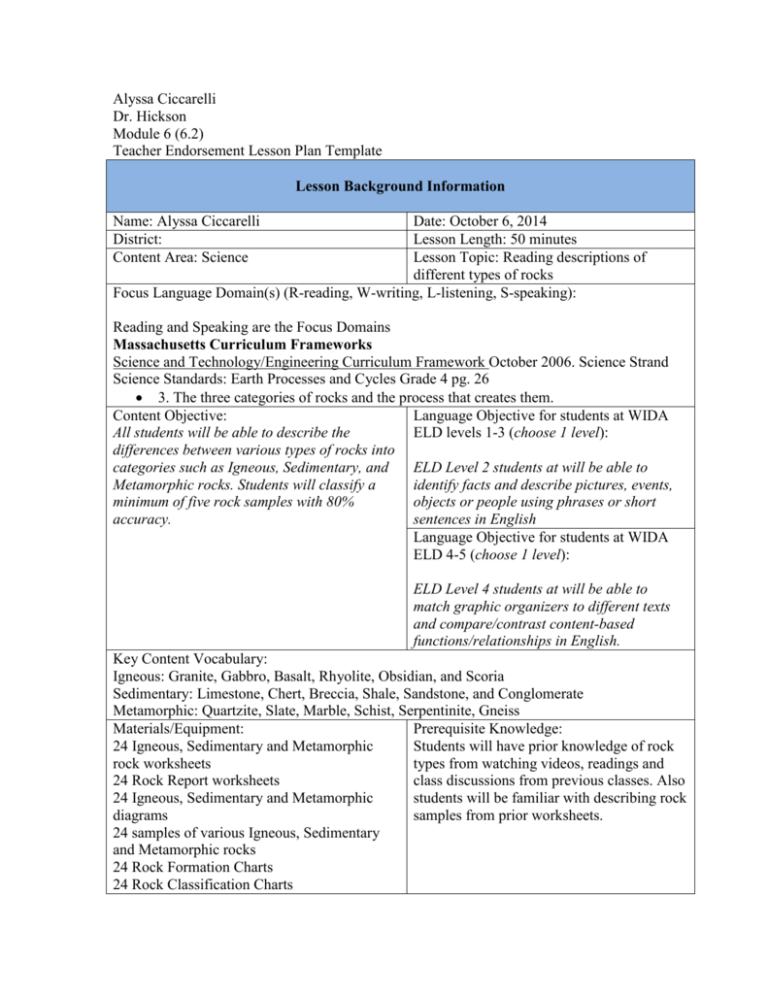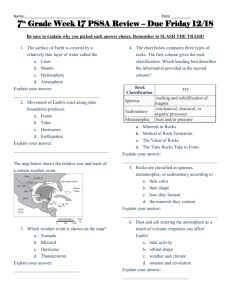Edu 348 z lesson 2 (1)
advertisement

Alyssa Ciccarelli Dr. Hickson Module 6 (6.2) Teacher Endorsement Lesson Plan Template Lesson Background Information Name: Alyssa Ciccarelli District: Content Area: Science Date: October 6, 2014 Lesson Length: 50 minutes Lesson Topic: Reading descriptions of different types of rocks Focus Language Domain(s) (R-reading, W-writing, L-listening, S-speaking): Reading and Speaking are the Focus Domains Massachusetts Curriculum Frameworks Science and Technology/Engineering Curriculum Framework October 2006. Science Strand Science Standards: Earth Processes and Cycles Grade 4 pg. 26 3. The three categories of rocks and the process that creates them. Content Objective: Language Objective for students at WIDA All students will be able to describe the ELD levels 1-3 (choose 1 level): differences between various types of rocks into categories such as Igneous, Sedimentary, and ELD Level 2 students at will be able to Metamorphic rocks. Students will classify a identify facts and describe pictures, events, minimum of five rock samples with 80% objects or people using phrases or short accuracy. sentences in English Language Objective for students at WIDA ELD 4-5 (choose 1 level): ELD Level 4 students at will be able to match graphic organizers to different texts and compare/contrast content-based functions/relationships in English. Key Content Vocabulary: Igneous: Granite, Gabbro, Basalt, Rhyolite, Obsidian, and Scoria Sedimentary: Limestone, Chert, Breccia, Shale, Sandstone, and Conglomerate Metamorphic: Quartzite, Slate, Marble, Schist, Serpentinite, Gneiss Materials/Equipment: Prerequisite Knowledge: 24 Igneous, Sedimentary and Metamorphic Students will have prior knowledge of rock rock worksheets types from watching videos, readings and 24 Rock Report worksheets class discussions from previous classes. Also 24 Igneous, Sedimentary and Metamorphic students will be familiar with describing rock diagrams samples from prior worksheets. 24 samples of various Igneous, Sedimentary and Metamorphic rocks 24 Rock Formation Charts 24 Rock Classification Charts Instructional Procedure Duration Description 5 minutes Connection to prior learning or background building activity: Students will have completed a worksheet on describing various types of rocks. Today the students will expand on their knowledge of Igneous, Sedimentary, and Metamorphic rocks by describing the different forms of each category of rocks. 20 minutes Activities, resources, and materials to present new content area knowledge or skill: Students will be in small groups and each group will have various samples of Igneous, Sedimentary, and Metamorphic rocks. The students will have a worksheet titled Rock Classification for easy reference for the names of the different forms of each Igneous, Sedimentary, and Metamorphic rock. The samples will provide a visual and sensory aid for ELL students. Group members will choose a sample of rock and describe its appearance to the group. After describing the rock, the group members will discuss which category the sample belongs to (Igneous, Sedimentary, and Metamorphic) based on prior knowledge of each rock characteristics. For example: Sample #1 appears to have a glass-like appearance, black in color and looks shiny or smooth texture. This sample could possibly be an igneous rock due to the glass-like appearance: glass is given a smooth/glossy exterior from intense heat. After correctly sorting the rocks into categories, the groups will decide from their Rock classification chart the correct name of each rock sample. For example: Sample # 2: described in appearance as black in color and contains numerous visible holes. They appear to be air bubbles that erupted under intense heat or pressure. After making these observations students look under igneous rocks and see which sample meets the description: in this case the sample is Scoria. ELD Level 2 students will be given worksheet with the names of various rock samples in English and they will be asked to identify the correct sample using phrases or short sentences. ELD Level 4 students will be given graphic organizers to compare and contrast Igneous, Sedimentary, and Metamorphic rocks categories. They will be provided with a Rock Report Worksheet for easy reference. They will the similarities and differences between the types of rocks. 15 minutes Activities, resources, and materials to present new language knowledge or skill: Students will have examples of rocks displayed on posters as a visual reference. Students will have a Rock formation worksheet and Igneous, Sedimentary and Metamorphic diagrams describing the development of each type of rock. 10 minutes Activities, resources, and materials to assess or review learning of new language, content, and/or skill: Sorting rocks with similar characteristics and describing the appearance of each unique rock will assess ELL level 2 students’ comprehension of the lesson objective. Comparing and contrasting the various rock samples using a graphic organizer will assess ELL level 4 students’ comprehension of the lesson content. General education students will be assessed on their ability to describe the physical appearance of the various rock samples and sort them according to their group’s characteristics. Example: Igneous rocks are formed from cooled lava. They may have crystals, air bubbles or glassy surface. They can also appear to be hard and dense. Homework/Extension Activities A practice worksheet for homework or independent work, which includes classification of Igneous, Sedimentary and Metamorphic rocks. Each student will be assigned different samples to identify and describe for homework. Visual aides such as diagrams and images will be used to accompany the worksheet for easy identification. Descriptive sentences: Students will explain their reasoning behind identifying the samples as Igneous, Sedimentary and Metamorphic rocks. The students will draw a picture of the rock for visual reference or model for future use in activities. Reflection: 1) What do you consider to be the most effective elements of this lesson to be for English learners? The most effective element of this lesson for the English Language Learners consists of visual components, sensory teaching and/or learning methods, and interactions within small groups. Also the reading and communication component of the lesson can be viewed beneficial for English Language Learners: the practice of oral communication to effectively describe the physical appearances of the rock samples to group members. 2) What feedback did you get from others (or determine for yourself) regarding the PLANNING of this lesson? The feedback I determined from planning of this lesson-included the incorporation of sensory learning. The sensory component in the lesson objective gives the students a physical approach in order to complete the lesson objective. They are able to pick up the rock samples, feel the different textures, as well as using the sample as a visual aid. The implementation of oral communication was beneficial for the English Language Learners to improve on their English proficiency.









